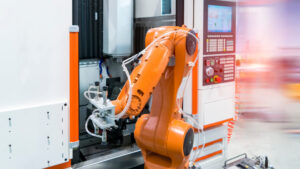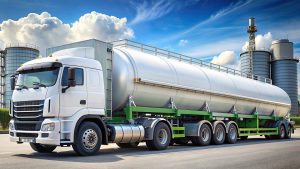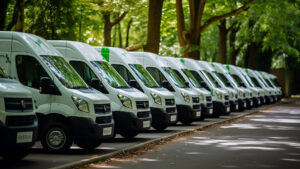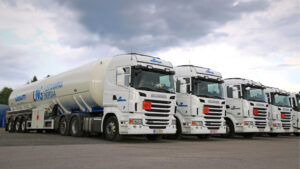Electric vehicles (EVs) are powering the move to a greener future and transforming the way we live and work. From family cars and motorcycles to commercial lorries and forklift trucks, EVs provide a sustainable alternative to the polluting combustion engine in line with the government’s 2050 Net Zero strategy.
Global volumes of electric vehicles grew 35% year-on-year in 2023 to 14.2 million units, and sales of EVs are expected to reach 16.6 million units in 2024 as we move further away from fossil-fuel power.
Today, electric forklift specialists, iLift are highlighting the top 5 industries that are reaping the rewards of electric vehicle adoption.
1. Transportation
Electric vehicles are revolutionising the world of transport wherever we look. Public transport operators are leveraging the benefits of electric trains, buses, taxis, and cars to achieve lower emissions and reduce maintenance costs while making our towns and cities cleaner places to live.
Similarly, apps such as Uber have pledged to become fully-electric and zero-emission by 2040 using the latest EV technology for their buses, trains, bicycles, and scooters to deliver goods and help people move around. Meanwhile, Lyft has set its sights on going 100% electric across its platform by 2030. Not only will this help drivers reduce their costs and earn more, but it will also lower its environmental impact.
At a time when many cities like London are charging drivers for fossil-fuelled vehicles to reduce air pollution, the rise in transport companies and public transport operators switching to green vehicles is set to continue.
2. Warehousing and Logistics
Industrial and commercial electric vehicles are ideal for warehouses and distribution centres, helping make the movement and the handling of goods greener than ever before.
Whether it’s electric forklifts for heavy lifting, or EV vans for delivering materials, electric power is helping operators reduce emissions, fuel costs, and maintenance to create a more sustainable working environment.
For instance, the sale of new battery electric vans rose by 21% in 2023 to reach a record 20,253 units as more and more companies adopt EV power in the workplace. Meanwhile, Walmart, the world’s largest retailer, announced it will be a zero emissions company by 2040, with all of its vehicles switching to EVs including long-haul trucks.
3. Package Delivery
Like transport, the delivery industry has taken a major turn towards electric vehicles with more EV vans and lorries on our roads than ever before. There were over 60,000 electric vans on UK roads at the end of May 2024, and that number is certain to rise with the arrival of new models and greater choice.
Global giant Amazon aims to transition to a fully electric fleet by 2030 as part of ‘The Climate Pledge,’ which it co-funded to challenge companies to commit to net-zero carbon emissions by 2040. Together with the adoption of 100,000 EVs, Amazon is now preparing its EV infrastructure by installing thousands of charge points in its delivery stations across Europe and North America.
Meanwhile, EVs are also making a positive impact in last-mile logistics – the final stage of delivery when a product or parcel lands on your doorstep. With city centres becoming harder and more expensive to access with large petrol or diesel vehicles, a range of compact and efficient electric utility vehicles and vans are now available. Not only are these EVs street legal, but they can reach limited-access areas and operate in pedestrian zones while cutting pollution.
Delivery giant FedEx aims to be half EV by 2025 and fully carbon neutral by 2040 and is expanding its international fleet by adding thousands of vehicles overseas including electric forklifts and airport equipment. Similarly, Tesco will be changing its fleet of home delivery vans to fully electric by 2030. It began the transition with 500 electric vans in 2020 and reduced its fleet emissions by 7,500 tonnes, replacing 15 million diesel delivery miles.
4. Breakdown and Recovery
With people driving electric vehicles in ever-increasing numbers, the likelihood of breakdowns also grows. Now, vehicle recovery operators have developed a smart solution that drivers can call upon when their EV runs out of juice.
For example, the RAC has created EV Boost which allows electric cars to be topped up at the roadside. Using the engine on a standard RAC patrol van to generate electrical power, it delivers a rapid electric charge that adds enough mileage to the stricken vehicle for it to reach a public charge point for further charging. By the end of 2024, the RAC hopes to have 200 vans equipped with EV Boost facilities on the road.
The RAC has also come up with a smart solution for towing EVs. Unlike traditional vehicles, as EVs can’t be towed with two wheels off the ground, the RAC has brought in Rapid Deployable Towing for transporting EVs when they break down.
Meanwhile, the AA has become the first roadside assistance provider to use fully electric vehicles following the launch of a new fleet of EV vans and trucks as it prepares to switch to net-zero emissions.
5. Construction
Construction has been quick to leverage the benefits of electric vehicles and machines as the industry looks to reduce its carbon footprint. With zero emissions and no exhaust fumes, battery-powered machines, diggers, trucks, and forklifts enable a sustainable way of working while maintaining maximum productivity.
According to research, the global electric construction equipment market is set to reach £54.9 billion by 2032 at an exponential growth of 23.5% over the next seven years. The rise in electric construction solutions has allowed businesses to reduce their operational costs thanks to lower running times for battery-powered machines compared to polluting diesel machines and zero idling.
Unless you turn it off, a diesel engine will keep running and spewing out fumes whereas electric construction machines stop working when you do. No idling also means less wear and tear and reduced maintenance, so your electric machine spends less time in the workshop and more time in operation, delivering greater efficiency.
Electric construction solutions also open up new business opportunities in the industry. With zero exhaust emissions and virtually no noise, construction firms can operate in places where diesel-powered machines cannot, such as indoor settings, during the night, and in low-emission zones. Not only that but construction EVs allow businesses to work near schools, hospitals, animals, and green spaces without any health risk or disturbance to sensitive environments.
As these five examples prove, electric vehicles are redefining the way companies work as we move towards a net zero environment. From electrified public transport to electric forklift trucks, battery-power is transforming industries in the journey towards a greener future.






